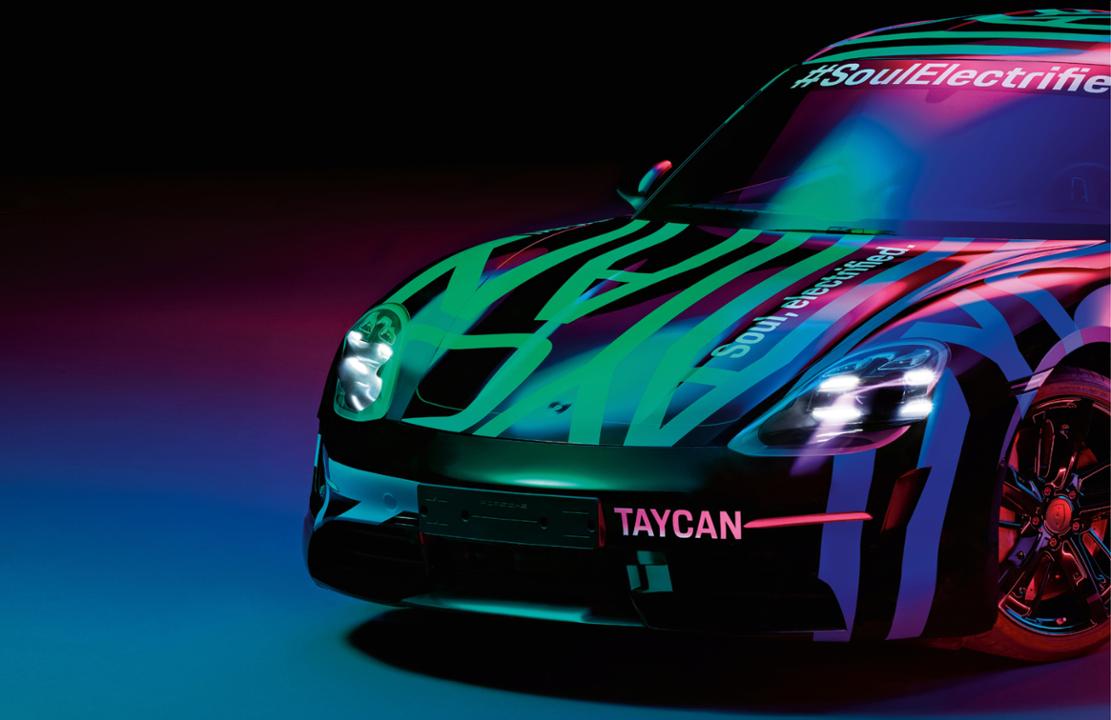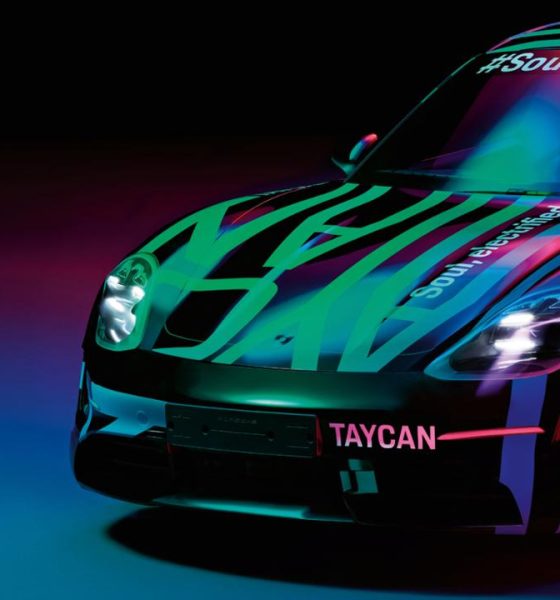

News
Porsche releases Taycan Cross Turismo production details, latest teasers for Taycan sedan
During Porsche’s annual press conference in Stuttgart last week, the company provided new details about the Taycan Cross Turismo, the Taycan sedan’s (formerly the Mission E concept car) more rugged sibling. The automaker noted that the Cross Turismo had been cleared for production next year, with the vehicle set to be produced alongside Taycan sedan in the company’s Zuffenhausen site.
The Taycan Cross Turismo is a valuable step forward for the automaker, which is currently pushing a shift towards the electrification of its fleet. The company expects to hire an additional 1,500 new employees for the launch of the Taycan sedan and the Taycan Cross Turismo, and it is also aiming to expand its electric lineup in the coming years. This initiative will continue with the EV version of its best-selling Macan SUV, which will be produced on Porsche’s Leipzig plant and built under parent company Volkswagen’s Premium Platform Electric (PPE) platform, which was co-developed by Porsche and Audi for larger vehicles.

The Porsche Taycan Cross Turismo prototype winter testing. (Photo: Tye/TaycanForum.com) 
Despite the Cross Turismo and the upcoming Macan EV both taking aim at the adventure/lifestyle market, Porsche board member in charge of sales and marketing Detlev von Platen noted during an interview with CNET Roadshow after the annual press conference that the two vehicles will not overlap. “The Cross Turismo concept is basically a more lifestyle-ish interpretation of the Taycan. It’s not directly targeting the SUV market,” he said.
Amidst the news of the Cross Turismo’s production, Porsche has also released a new batch of teaser photos for the Taycan sedan, which is expected to be released later this year. This time around, it is not the Mission E concept car that the company is showcasing. Instead, the German carmaker is featuring what appears to be a production-ready version of the vehicle, or at least something close to it.
The images, which were released by Porsche, showcase a vehicle covered in some colorful camouflage. Small details of the car are a bit hard to make out due to its wrap, but the words “#SoulElectrified” and “Taycan” give the vehicle away. Based on the general appearance of the camouflaged car, it appears that the Taycan will be somewhat close to the design of the refined test mules that have been spotted winter testing as of late.

(Photo: Porsche GB/Twitter) 
(Photo: Porsche GB/Twitter) 
(Photo: Porsche GB/Twitter) 
(Photo: Porsche GB/Twitter)
Similar to Porsche’s recent prototypes, the Taycan in the new teaser photos sports a headlight design that follows the theme of the current 718 Cayman and Boxster sports cars, both of which sport four LED daytime running lights. A full-width light bar at the rear is also present, invoking a design element from the company’s flagship vehicle, the new Porsche 911. These flourishes do not mean that the stunning lines of the Mission E concept are gone, as elements from the futuristic sedan such as its low nose and rakish roofline remain.
The Porsche Taycan is expected to be released this coming September. The company notes that the sedan will be capable of sprinting from 0-60 mph in under 3.5 seconds, while having a range of over 300 miles on one charge. The Taycan is also designed to be charged at 350 kW, allowing owners of the car to replenish over 60 miles of range in just 4 minutes.

News
Tesla FSD fleet is nearing 7 billion total miles, including 2.5 billion city miles
As can be seen on Tesla’s official FSD webpage, vehicles equipped with the system have now navigated over 6.99 billion miles.

Tesla’s Full Self-Driving (Supervised) fleet is closing in on almost 7 billion total miles driven, as per data posted by the company on its official FSD webpage.
These figures hint at the massive scale of data fueling Tesla’s rapid FSD improvements, which have been quite notable as of late.
FSD mileage milestones
As can be seen on Tesla’s official FSD webpage, vehicles equipped with the system have now navigated over 6.99 billion miles. Tesla owner and avid FSD tester Whole Mars Catalog also shared a screenshot indicating that from the nearly 7 billion miles traveled by the FSD fleet, more than 2.5 billion miles were driven inside cities.
City miles are particularly valuable for complex urban scenarios like unprotected turns, pedestrian interactions, and traffic lights. This is also the difference-maker for FSD, as only complex solutions, such as Waymo’s self-driving taxis, operate similarly on inner-city streets. And even then, incidents such as the San Francisco blackouts have proven challenging for sensor-rich vehicles like Waymos.
Tesla’s data edge
Tesla has a number of advantages in the autonomous vehicle sector, one of which is the size of its fleet and the number of vehicles training FSD on real-world roads. Tesla’s nearly 7 billion FSD miles then allow the company to roll out updates that make its vehicles behave like they are being driven by experienced drivers, even if they are operating on their own.
So notable are Tesla’s improvements to FSD that NVIDIA Director of Robotics Jim Fan, after experiencing FSD v14, noted that the system is the first AI that passes what he described as a “Physical Turing Test.”
“Despite knowing exactly how robot learning works, I still find it magical watching the steering wheel turn by itself. First it feels surreal, next it becomes routine. Then, like the smartphone, taking it away actively hurts. This is how humanity gets rewired and glued to god-like technologies,” Fan wrote in a post on X.
News
Tesla starts showing how FSD will change lives in Europe
Local officials tested the system on narrow country roads and were impressed by FSD’s smooth, human-like driving, with some calling the service a game-changer for everyday life in areas that are far from urban centers.

Tesla has launched Europe’s first public shuttle service using Full Self-Driving (Supervised) in the rural Eifelkreis Bitburg-Prüm region of Germany, demonstrating how the technology can restore independence and mobility for people who struggle with limited transport options.
Local officials tested the system on narrow country roads and were impressed by FSD’s smooth, human-like driving, with some calling the service a game-changer for everyday life in areas that are far from urban centers.
Officials see real impact on rural residents
Arzfeld Mayor Johannes Kuhl and District Administrator Andreas Kruppert personally tested the Tesla shuttle service. This allowed them to see just how well FSD navigated winding lanes and rural roads confidently. Kruppert said, “Autonomous driving sounds like science fiction to many, but we simply see here that it works totally well in rural regions too.” Kuhl, for his part, also noted that FSD “feels like a very experienced driver.”
The pilot complements the area’s “Citizen Bus” program, which provides on-demand rides for elderly residents who can no longer drive themselves. Tesla Europe shared a video of a demonstration of the service, highlighting how FSD gives people their freedom back, even in places where public transport is not as prevalent.
What the Ministry for Economic Affairs and Transport says
Rhineland-Palatinate’s Minister Daniela Schmitt supported the project, praising the collaboration that made this “first of its kind in Europe” possible. As per the ministry, the rural rollout for the service shows FSD’s potential beyond major cities, and it delivers tangible benefits like grocery runs, doctor visits, and social connections for isolated residents.
“Reliable and flexible mobility is especially vital in rural areas. With the launch of a shuttle service using self-driving vehicles (FSD supervised) by Tesla in the Eifelkreis Bitburg-Prüm, an innovative pilot project is now getting underway that complements local community bus services. It is the first project of its kind in Europe.
“The result is a real gain for rural mobility: greater accessibility, more flexibility and tangible benefits for everyday life. A strong signal for innovation, cooperation and future-oriented mobility beyond urban centers,” the ministry wrote in a LinkedIn post.
News
Tesla China quietly posts Robotaxi-related job listing
Tesla China is currently seeking a Low Voltage Electrical Engineer to work on circuit board design for the company’s autonomous vehicles.

Tesla has posted a new job listing in Shanghai explicitly tied to its Robotaxi program, fueling speculation that the company is preparing to launch its dedicated autonomous ride-hailing service in China.
As noted in the listing, Tesla China is currently seeking a Low Voltage Electrical Engineer to work on circuit board design for the company’s autonomous vehicles.
Robotaxi-specific role
The listing, which was shared on social media platform X by industry watcher @tslaming, suggested that Tesla China is looking to fill the role urgently. The job listing itself specifically mentions that the person hired for the role will be working on the Low Voltage Hardware team, which would design the circuit boards that would serve as the nervous system of the Robotaxi.
Key tasks for the role, as indicated in the job listing, include collaboration with PCB layout, firmware, mechanical, program management, and validation teams, among other responsibilities. The role is based in Shanghai.
China Robotaxi launch
China represents a massive potential market for robotaxis, with its dense urban centers and supportive policies in select cities. Tesla has limited permission to roll out FSD in the country, though despite this, its vehicles have been hailed as among the best in the market when it comes to autonomous features. So far, at least, it appears that China supports Tesla’s FSD and Robotaxi rollout.
This was hinted at in November, when Tesla brought the Cybercab to the 8th China International Import Expo (CIIE) in Shanghai, marking the first time that the autonomous two-seater was brought to the Asia-Pacific region. The vehicle, despite not having a release date in China, received a significant amount of interest among the event’s attendees.











